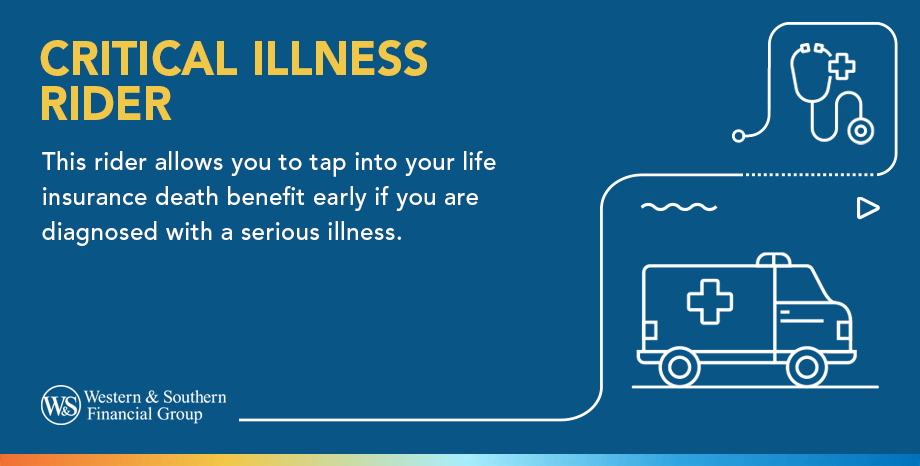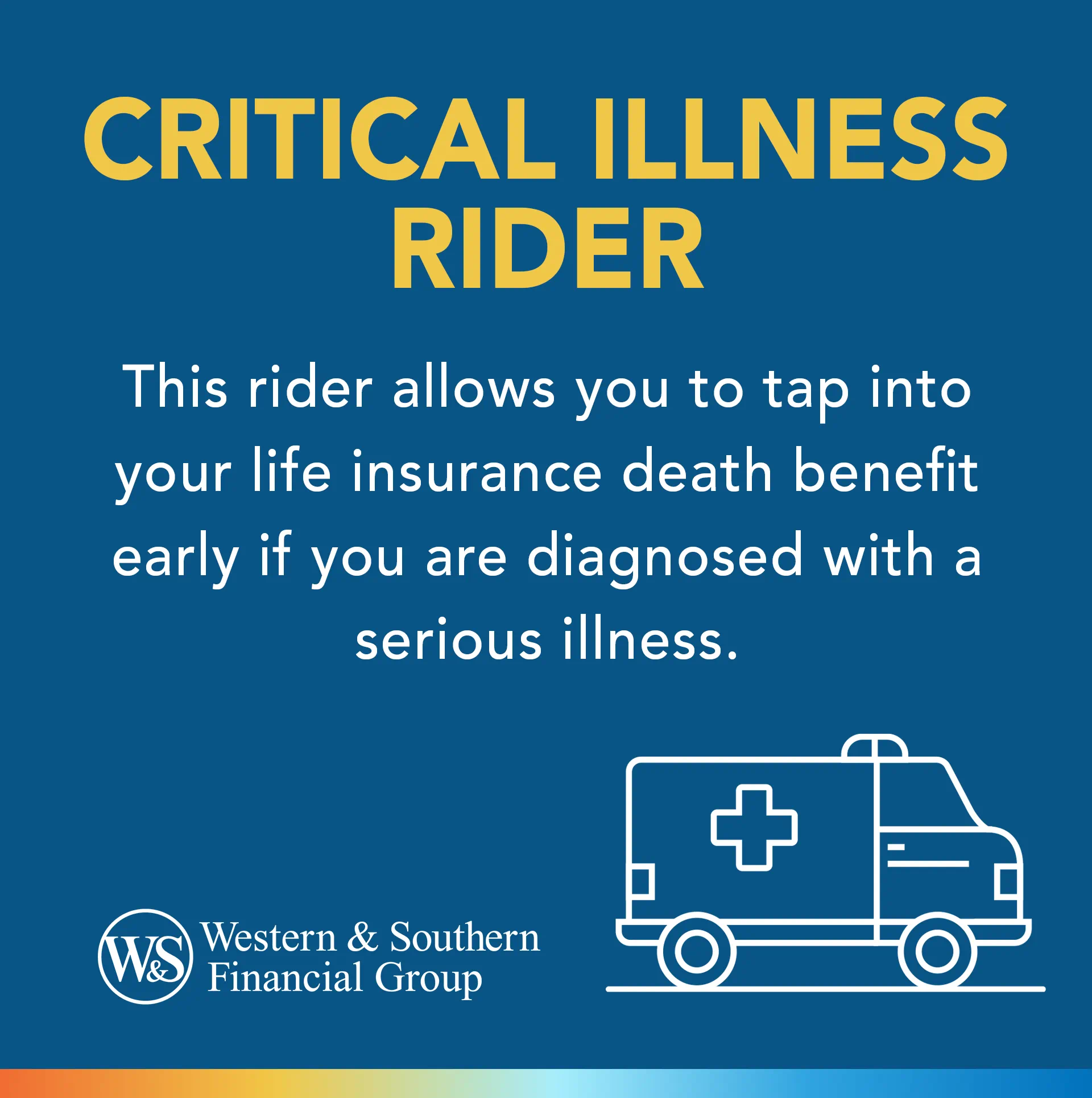

Table of Contents
- What Is a Critical Illness Rider?
- How Does a Critical Illness Rider Work?
- What Does a Critical Illness Rider Cover?
- What Does a Critical Illness Rider Exclude?
- What Are the Benefits of a Critical Illness Rider?
- What Are the Potential Drawbacks of a Critical Illness Rider?
- Is the Critical Illness Rider Right for You?
- Are Critical Illness Riders Worth It?
- Bottom Line
- Frequently Asked Questions
Key Takeaways
- A Critical Illness Rider allows you to tap into your life insurance death benefit early if you are diagnosed with a serious illness.
- The rider offers coverage for a wide range of critical illnesses but also comes with specific exclusions.
- Benefits include financial assistance and flexibility in using funds.
- This rider's premium can be added to the main policy's premium or charged separately.
- If a claim is made, the rider typically terminates, or the primary policy's sum assured may reduce.
What Is a Critical Illness Rider?
A life insurance Critical Illness Rider is an add-on provision to a life insurance policy that provides additional coverage if the policyholder is diagnosed with one of the specified critical illnesses. These illnesses often include severe conditions like heart attack, stroke, cancer, kidney failure, and certain types of surgeries.
A Critical Illness Rider can be added to permanent life insurance policies such as whole life insurance or universal life insurance. Depending upon the insurance company, it may also be added to a term life insurance policy. Additionally, an employer may offer this rider as an option on a Group Life insurance or Group Health insurance policy.
Understanding what a Critical Illness Rider is has significant implications for those seeking comprehensive protection through their life insurance policies. This rider serves as a critical safety net for policyholders during trying times by providing a life insurance living benefit that enables access to funds otherwise inaccessible until after death.
How Does a Critical Illness Rider Work?
Here's a basic step-by-step explanation of how the rider works:
Purchase: When purchasing a life insurance policy, you may have the option to add a Critical Illness Rider for an additional premium.
Coverage List: The rider will specify which critical illnesses are covered. Commonly covered conditions include heart attacks, strokes, specific types of cancer, major organ transplants, and more.
Diagnosis: If, during the policy term, the policyholder is diagnosed with one of the covered critical illnesses, they become eligible for a claim.
Claim Process: Once diagnosed, the policyholder (or their representative) files a claim with the insurance company. The claim typically requires medical documentation or certification to validate the diagnosis.
Waiting and Survival Period: Many policies have a waiting period from the start date of the rider before any claims can be made. After diagnosis and claim submission, there might also be a survival period. This means the policyholder must survive for a certain number of days post-diagnosis to be eligible for the benefit.
Payout: After validating the claim and ensuring all conditions are met, the insurance company provides a lump sum payout. This amount is predetermined and stated in the rider.
Usage of Funds: The lump sum payout is not restricted to only medical bills or expenses. It can cover treatment costs, pay off debts, compensate for lost income during recovery, or any other purpose the policyholder sees fit.
Termination or Reduction: Once the lump sum is paid out, the critical illness rider typically either terminates or, in some cases, the base policy's sum assured may be reduced by the payout amount.
Premiums: Premiums for the rider are either added to the primary policy's premium and paid together or might be charged separately. The amount can vary based on factors like the policyholder's age, medical history, and the breadth of coverage.
Exclusions: Being aware of any exclusions in the rider is crucial. Some riders might not cover illnesses resulting from pre-existing conditions or specific circumstances (like illnesses due to drug abuse or self-inflicted injuries).
It's important to note that the specifics of a life insurance policy's death benefit and life insurance riders can vary depending on the insurance company and the specific policy terms and conditions. Always review the policy's details and consult with an insurance professional to fully understand life insurance options' benefits, limitations, and costs.
What Does a Critical Illness Rider Cover?
A Critical Illness Rider covers a predefined list of severe health conditions. While the specific illnesses covered can vary from one insurance provider to another, several common conditions may be covered:
Heart-Related Conditions: Heart Attack, coronary artery bypass surgery, angioplasty, and other invasive treatments for coronary artery disease.
Cancers: Most types of major cancers that are invasive and life-threatening, excluding less severe forms like early-stage cancers or non-melanoma skin cancers.
Neurological Conditions: Stroke, Multiple sclerosis with persisting symptoms, Parkinson's disease, and Alzheimer's disease.
Organ Conditions: Major organ transplant (like kidney, heart, lung, liver, or pancreas), Kidney failure requiring regular dialysis.
Other Serious Conditions: Paralysis, Coma, Severe burns, Blindness or loss of sight, Deafness or loss of hearing, and Loss of speech
Surgical Procedures: Aortic surgery and Heart valve replacement or repair
Respiratory Diseases: Severe lung disease requiring long-term oxygen therapy
Infectious Diseases: Human Immunodeficiency Virus (HIV) contracted from blood transfusions, organ transplants, or at work for medical professionals, and Hepatitis B or C
The above list is illustrative and not exhaustive. The exact coverage will depend on the insurance provider and specific policy provisions. There are often specific criteria or definitions for each qualifying condition that must be met for a claim to be valid. Pre-existing conditions and specific scenarios (like illnesses due to drug abuse or self-inflicted injuries) might be excluded. Some medical conditions may require waiting periods.
When considering a Critical Illness Rider, it's vital to review the policy document closely to understand precisely which illnesses are covered, under what conditions, and any associated exclusions or limitations. Each insurer has specific criteria determining what illnesses qualify for a Critical Illness benefit.
What Does a Critical Illness Rider Exclude?
A Critical Illness Rider, like other insurance products, has specific exclusions. The insurance company will not pay out a benefit under these conditions or scenarios. The exact exclusions can vary among insurance providers and policies, but standard exclusions often include the following:
Pre-existing Conditions: Illnesses or conditions the policyholder had before obtaining the insurance or within a specific duration after the policy inception might not be covered.
Specific Types or Stages of Illnesses: Only specific types or stages might be covered for diseases like cancer, excluding others. For instance, early-stage cancers or non-melanoma skin cancers might be excluded.
Drug or Alcohol-Induced Conditions: Illnesses or conditions caused due to excessive intake of alcohol, drug abuse, or taking drugs not prescribed by a certified medical practitioner.
Self-inflicted Injuries: Conditions arising out of self-inflicted injuries or attempted suicide.
Participation in Hazardous Sports or Activities: Injuries or illnesses resulting from the insured's participation in risky sports or activities, like parachuting, bungee jumping, racing, etc.
Criminal Activity: Any injury or illness resulting from the policyholder committing an unlawful or illegal act.
Cosmetic Surgery or Treatment: Conditions arising from cosmetic or elective treatments unless they arise from an accident or are required as a part of medically necessary treatments.
Reading the policy document thoroughly is important to understand all the exclusions associated with a Critical Illness Rider. Consulting with an insurance agent or financial professional can also help clarify the specifics of a policy's exclusions.
What Are the Benefits of a Critical Illness Rider?
A Critical Illness Rider offers several benefits. Here are the main advantages:
- Lump Sum Payment: Upon diagnosis of a covered critical illness, the policyholder receives a lump sum. This immediate financial assistance can be invaluable, especially when the person is unable to work or generate income.
- Flexibility in Fund Usage: The payout from a Critical Illness Rider is not restricted to medical expenses.
- Comprehensive Coverage: It complements standard health insurance, which typically covers only hospitalization expenses.
- Financial Serenity: Knowing that there's financial support in case of a significant health crisis offers emotional and mental relief, reducing stress during an already challenging time.
- No Need for Separate Policy: Instead of buying a standalone critical illness policy, adding a rider to an existing policy might be more cost-effective and convenient.
- Support for Family: If the primary earner in a family is diagnosed with a critical illness, the financial implications can be immense. The payout can ensure that the family's lifestyle and essential expenses, like children's education, are not heavily impacted.
- Hedge Against Medical Inflation: Medical costs are rising, especially for severe illnesses. A Critical Illness Rider can act as a hedge against such medical inflation, ensuring that you have financial assistance if needed.
- Coverage Until Advanced Age: Some critical illness riders offer coverage up until advanced ages, providing protection during periods when individuals might be more susceptible to certain illnesses.
While there are undeniable benefits to having a Critical Illness Rider, it's essential to evaluate one's personal health risk, family history, financial situation, and insurance coverage before deciding to add such a rider. It's also vital to thoroughly understand the terms, conditions, covered illnesses, and exclusions of the rider. Nearly 40% of people will receive a cancer diagnosis in their lifetime.2
What Are the Potential Drawbacks of a Critical Illness Rider?
While a Critical Illness Rider can provide several benefits, there are potential drawbacks to consider:
- Additional Premiums: Adding a Critical Illness Rider to your insurance policy often means paying a higher premium. Over the term of the policy, these costs can add up.
- Limited Coverage: Critical Illness Riders typically cover a specific list of illnesses. If you're diagnosed with a condition not on that list, you won't receive any benefits, even if the disease is severe.
- Specific Definitions: The policy might have specific definitions for each covered illness. For instance, certain stages or types of cancer might be excluded, or a heart attack might need to meet particular severity criteria.
- One-time Payout: Typically, once you claim the benefit for one critical illness, the rider terminates, or the payout amount may reduce the sum assured of the main policy. You might not be covered if you suffer from another critical illness later on.
- Waiting Periods: Many policies have waiting periods, meaning if you're diagnosed with a critical illness shortly after the policy starts, you may not be eligible for a claim.
- Survival Period: Some policies have a survival clause where the policyholder needs to survive a specified number of days after the diagnosis to be eligible for a claim.
- Potential Overlap with Other Policies: If you already have comprehensive health or disability insurance, there may be some overlap in the coverage provided by a critical illness rider, leading to redundant coverages.
- Exclusions: As with all insurance products, there will be specific exclusions where the rider won't pay.
- Benefit Proportions: Some riders might only pay a percentage of the coverage for specific conditions. For instance, you might only get 25% of the sum assured for angioplasty, even though you might get 100% for a heart attack.
- Policy Tenure: Some riders might not provide coverage up to advanced ages, potentially leaving individuals unprotected during periods of higher health risk.
As with any financial decision, it's essential to weigh the potential benefits and drawbacks based on your circumstances and determine if a Critical Illness Rider fits your needs.
Is the Critical Illness Rider Right for You?
Whether a Critical Illness Rider is worth it depends on individual circumstances, needs, and financial planning goals. Here are some factors to consider:
Personal and Family Health History: If your family has a history of critical illnesses, investing in the rider might be a prudent choice.
Financial Situation: Take a moment to evaluate your savings and financial situation, and have a plan to cover the significant costs that may arise from serious health issues. Hospital stays can add up to tens of thousands of dollars. The ballpark estimate for cancer treatment is around $150,000.3 If a critical illness could derail your financial plans or put undue strain on your savings, the rider might offer essential protection.
Age: As you age, the risk of critical illnesses generally increases. Older individuals might find more value in such riders, but premiums could also be higher.
Employment Benefits: Some employers provide critical illness coverage as a part of their benefits package. Ensure you're not doubling up on coverage. It's also a good idea to review the details of your health insurance plan. It may cover some but not all of the costs associated with critical illnesses.
Alternative Products: There are standalone critical illness policies available in the market. Sometimes, these can provide broader coverage or better terms than a chronic illness rider attached to a life or health insurance policy. It's worth comparing the two.
It can be difficult to imagine a day when you might receive a severe medical diagnosis; no one likes to envision such a scenario. But some critical illnesses are common: Nearly 800,000 Americans have a stroke yearly, and strokes are the most common cause of adult disability.1
As with all financial decisions, discussing your options with a financial advisor or insurance professional is recommended. They can help you evaluate the costs and benefits of financial protection based on your specific needs and goals.
Remember that various types of life insurance policies and optional life insurance riders may suit your needs and financial and living situation. It is essential to take the time to thoroughly research buying life insurance and consider all available options, taking into account your financial objectives, life insurance coverage needs, family, and personal preferences.
The costs of cancer treatment are constantly on the rise as new treatments are developed.4 Understanding your risk factors and likelihood of receiving a critical illness diagnosis can be helpful as you plan for the future.
Are Critical Illness Riders Worth It?
The answer to this question is highly personal — and you're the only one who can decide — but there are some considerations to take into account as you consider for yourself.
For many people, a critical illness rider provides some reassurance that they will be better able to address the expenses if they ever receive a serious medical diagnosis. This is often a compelling enough reason to add a critical illness rider.
You may also want to evaluate your savings and consider how you would pay for the potentially hefty expenses associated with serious health conditions. Hospital stays can add up to tens of thousands of dollars. The ballpark estimate for cancer treatment is around $150,000.3
It's also a good idea to review the details of your health insurance plan. It may cover some but not all of the costs associated with critical illnesses. You may encounter expenses you never expected, such as having to hire someone to help clean your home or employing a caretaker for hands-on assistance. Even transportation to and from medical appointments can add up quickly. Think about whether you already have a savings cushion that could support you and your family for months or years while you manage your health or if you might benefit from the option to tap into your life insurance benefits early.
Bottom Line
The choice to add a critical illness rider to your life insurance policy comes down to your values and your budget. Adding one usually means an extra cost. If you can't afford a higher premium for the rider's additional coverage, it may not be worth stretching your budget to add it. You might also decide that a rider isn't in your budget now but could be if your income increases or your budget frees up.
Before deciding whether a specific type of rider is worth it for you, it's a good idea to compare different types of riders. Depending on your lifestyle and your priorities, it may make sense for you to personalize your life insurance policy with another type of rider, such as accidental death or long-term care. A qualified financial professional can help you weigh your options and consider your particular circumstances to decide what coverage may better suit your needs.
Frequently Asked Questions
What is the difference between a critical illness rider and critical illness insurance?
Both the Critical Illness Rider and Critical Illness Insurance aim to provide financial protection in the event of specific severe health conditions; the primary distinction is their structure.
Critical Illness Rider: A rider supplements a life insurance policy that can offer a lump sum payout for covered illnesses. It may be cheaper than standalone critical illness insurance, but the coverage and payout amount depends on the primary policy's terms. If the primary policy ends, the rider will too.
Critical Illness Insurance: Critical Illness Insurance is a standalone policy that provides coverage for critical illnesses. Standalone policies may offer more customization options, broader coverage, or more specific conditions for claims. Premiums vary based on coverage specifics, age, health, and other factors. This policy is independent and not tied to any other insurance contract.
What is the difference between critical illness and health insurance?
Critical Illness and Health Insurance provide financial coverage related to health conditions, but they have distinct features and different purposes.
Critical Illness Insurance: Critical Illness Insurance provides a lump-sum payout for specific illnesses, such as cancer, stroke, or heart attack. The money can be used for medical costs, other daily living expenses, or lost income. The policy covers a predefined list of severe illnesses. Once a claim is made and paid out, the policy usually ends.
Health Insurance: Health Insurance covers medical expenses and treatments like doctor visits, surgeries, and medications. There may be out-of-pocket expenses before the insurance covers the extra cost. It doesn't provide a lump sum for a diagnosis like Critical Illness Insurance.
While Critical Illness Insurance offers financial support to cope with the financial challenges of major health conditions, Health Insurance covers routine and significant healthcare needs. Depending on individual circumstances, having both types of insurance can provide comprehensive financial protection against health-related uncertainties.
Sources
- Brain basics: Preventing stroke. National Institutes of Health. https://www.ninds.nih.gov/health-information/patient-caregiver-education/brain-basics-preventing-stroke.
- Lifetime Risk of Developing or Dying From Cancer. https://www.cancer.org/cancer/risk-prevention/understanding-cancer-risk/lifetime-probability-of-developing-or-dying-from-cancer.html.
- The cost of cancer. SERO Group. https://treatcancer.com/blog/cost-of-cancer/#how-much-does-cancer-cost.















